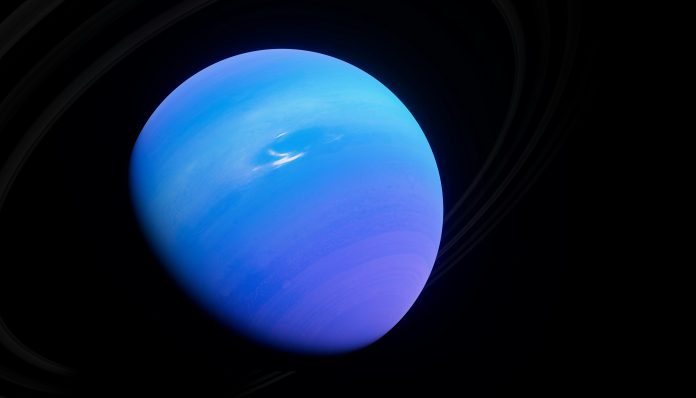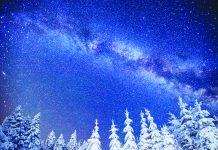Similar to Jupiter and Saturn, Uranus and Neptune’s atmospheres consist of hydrogen and helium, but the bulk of each planet is a frozen slush of water, methane, and ammonia, hence their nickname ‘ice giants.’
Uranus
- Seventh planet from the Sun
- If the Sun is at a football field’s goal post and Earth is on the 2-yard line, Uranus is at the 38-yard line
- Third largest planet, 63 Earths could fit inside
- Rotates on its axis in 17 hours. Takes 84 years to orbit the Sun
- Takes sunlight 2.5 hours to get there
- Lacks a hard surface. Despite being closer to the Sun than Neptune, Uranus is the coldest planet in the solar system at -224 degrees Celsius
- Has 27 moons and thirteen rings
- Very stormy atmosphere with wind speeds over 900 km/hr
- Early in life, a collision with an Earth sized object left it with a tilt of almost 90 degrees; meaning Uranus is literally lying on its side. As a result, summer on Uranus is 21 years of sunshine while winter is 21 years of darkness
Neptune
- Eighth planet and furthest from the Sun
- If the Sun is at a football field’s goal post and Earth is on the 2-yard line, Neptune is at the opposing team’s 50-yard line
- Fourth largest planet, 57 Earths could fit inside
- Rotates on its axis in 15 hours. Takes 165 years to orbit the Sun
- Takes sunlight four hours to get there
- Lacks a hard surface. Mean temperature: -200 degrees Celsius
- Has 14 moons and five very faint rings
- Stormiest atmosphere in the solar system with wind speeds over 2000 km/hr
- 8,000 km below the surface of both Uranus and Neptune, hydrogen and carbon are squeezed together under incredible pressure. The result is rain, not of water droplets, but of diamonds!










